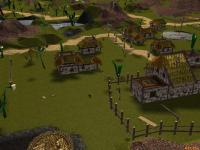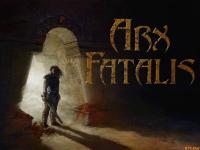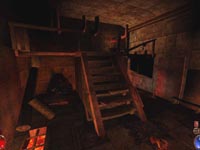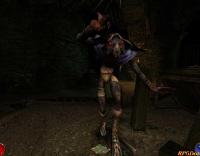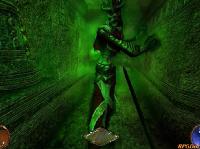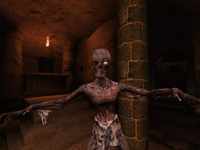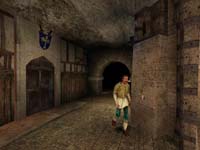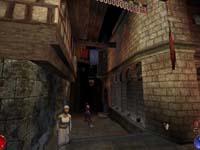|
|
|
Main News Forums Games Games Database Top 100 Release List Support Files Features Reviews Previews Interviews Editorials Diaries Misc Download Gallery Music Screenshots Videos Miscellaneous Staff Members Privacy Statement |
ARX POSTMORTEM Raphael Colantonio
Things that went right: A clear vision of the goals: We precisely knew what game we wanted to achieve and what elements we wanted to show. The game designers worked perfectly together. We had a long pre-production phase, we met together a lot and we had much time to think. Thanks to this, we could work in-depth on the puzzles, atmosphere and game mechanics. The game design document was well made and it provided a good development bible for the rest of the team.
The in-house team was kept as small as possible, basically, the idea was to keep the creative input amongst a very small amount of people. This would accelerate decisions, reduce ego and management issues. It revealed to be a very good way to keep costs low. Obviously, this system wasn't perfect (during crunch time for example), but overall we found out that it's a really good and efficient way to manage a project. Our contractors were really great, we worked with responsible people who (almost) always delivered assets in time and quality. Then, there was a significant time that needed to be taken into consideration for integration of the externalized work (which we've underestimated a bit sometimes). To be fair, I would say we should have hired a few more people in-house. The fear of running over the budget stopped us from hiring, but looking back at things, we would have been more efficient by hiring a few more people when the project started to run under pressure. Something I'll remember for the next game.
Another example: We had to rewrite the story half way down the development. The main story was written since the very beginning, but we found out in the middle of the production that there was not enough surprises and twists, so we broke it all, and tried to rebuild the most interesting plot as possible: What turned out to be hard was to keep the elements that were set in stone by the work we had already done such as puzzles, characters, level designs, etc... That was quite a nightmare and a very interesting exercise at the same time, as we had the feeling of working in a reverse way. But as strange as it might sound, it also allowed us to end up with an interesting complex story that we could probably have never written if we had done it the 'right' way.
Things that went wrong: A big waste of time with the text writings: On the Script writing side, I think we did something quite uncommon that wasted a lot of our time: Though we are a French developer, we decided that the primary language for the game would be English, mainly because the big part of consumers speak English, and also because we thought it would be better when showing the game to publishers. So, we started writing our internal docs in English. Well… in something that looks like English written by French people. Later on, once we had all the dialogs and the texts written, we contracted a French writer who's job was to translate our strings, and most of all: adding some style to our dialogs and books. Once the job was done, we were a bit disappointed with the style that was too 'written' and not 'talked' enough, so we spent some time modifying some strings that we didn't like. Then, we sent them to translation into real English (there are many companies who are specialized into game translation). Once the English texts game back to us, we started to waste some time correcting all basic mistakes made by the fact that the translators didn't know all aspects and elements of the game (standard issue). Then, when we sent the scripts to the recording studio in the US for speech recording. The guy sent me a mail saying that many strings were really 'naive' and bland in the writing for this type of dark serious game. So, we contracted an American to give a bit of 'punch' to our texts and dialogs. The texts came back to us and we were happy with them. But then we had to re-affect all the changes on the French strings that were already written ! And only then, our nightmare did come to an end: Texts were finalized and ready for German and Italian translation. Next time, we'll get a native English to write our texts from scratch.
Most 1st person games use CSG editors, and that's not an accident. It is definitely the most adapted tools for game designers to conceive worlds in true 3D. The drawback is that maps appear usually a bit blocky and 'geometric', but the solution might be to use the CSG method only to block out maps, then export the mesh to Maya or Max so that real graphic artists can work on it. Anyway, once we finally managed to rework the basic meshes to reach a level of 3D that was good enough, we handed them to the Graphic department who's task was to change our horrible blocky maps into something immersive and pretty.
One guy alone had to work on the tools, the engine, the pre-production, together with making a cool tech demo to seduce publishers… Well, he did it ! we had a tech demo which was pretty advanced and convincing… But then everything should have been scrapped and redone in a clean way if we had done things right. Instead, we inherited a rushed engine that was used for the prototype. As a result, the entire production was built upon a dangerously heavy base that didn't always feature the right decisions, and new programmers found it difficult to plug their code in. Most additions would cause bugs and crashes and would require some heavy debugging time. Probably all this was due to the fear of being late. Anyway, at the end we managed to obtain a code that was stable, but at the cost of loooong extra hours and stress. Underestimation of the Play Testing task: We assumed that the testing made by the publisher would be enough… Unfortunately, we've discovered that remote testing and debugging doesn't work very well. The tests made by the publisher are good for language testing, quality insurance and hardware compatibility, but the rest needs to be tested in-house. This is not something we had included in our initial budget, but we hired 5 testers in-house for about 4 months in order to accelerate the testing procedure. Still we didn't find all the bugs (the game being so big), and it took a few patches to remove them all. Raphael Colantonio
Average Reader Ratings: 7.95 (337 votes) |
||||||||||
|
All original content of this site is copyrighted by RPGWatch. Copying or reproducing of any part of this site is strictly prohibited. Taking anything from this site without authorisation will be considered stealing and we'll be forced to visit you and jump on your legs until you give it back. |
||




